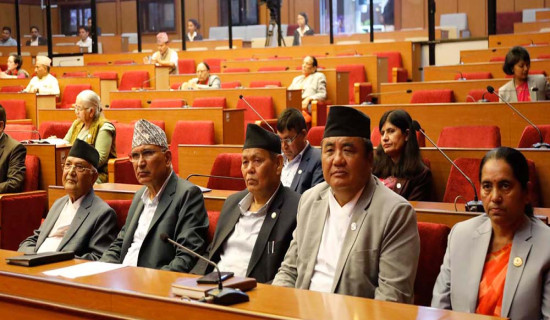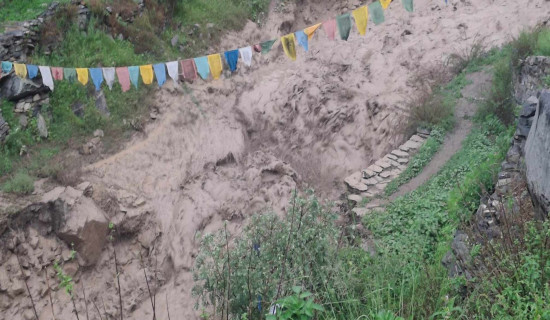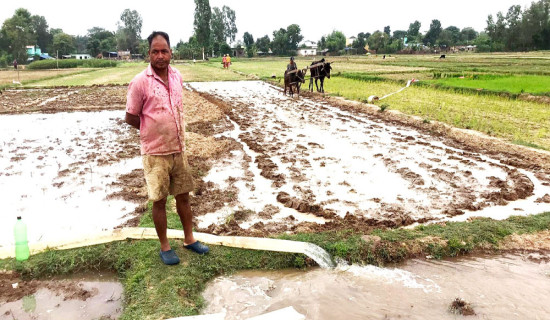- Wednesday, 30 July 2025
Kathmandu sees restaurant culture booming
BY SUSHMA MAHARJAN,Kathmandu, July 8: On any evening in Kathmandu, it’s hard to miss the lively chatter spilling out of restaurants in Jhamsikhel, Sanepa, Thamel, Basantapur, or Bouddha. Whether it's sizzling momo platters, wood-fired pizzas, Korean barbecue, or vegan bowls, the capital’s restaurant expanse has exploded in recent years.
“I remember the time when going out for lunch used to be a once-a-week luxury. Now, it’s almost a daily habit,” says Nirajan Rai, 33, who works at a cooperative.
But, this shift isn’t just about convenience. Eating out has become a lifestyle experience, especially for Kathmandu’s growing middle class and youth population. Rooftop restaurants with scenic views, Instagram-friendly interiors, live music venues, and food-themed pop-ups are all part of this evolving urban lifestyle.
“I used to just grab a milk tea for Rs. 30 from the chiya pasal near my college, but now my friends and I spend hours at coffee shops and restaurants. It’s more of a hangout than just grabbing food and drink,” said Riya Sharma, 18, studying at Grade 12 at Annapurna National College.
Lately, Kathmandu has seen a sharp rise in cafes/restaurants catering to youth and urban professionals. This trend has especially flourished in the Sanepa and Jhamsikhel area, popularly known as ‘Jhamel’ among the youth. Even Bhaktapur, traditionally more conservative in lifestyle, hasn’t remained untouched by this phenomenon, including outside ring road areas.
“People want more than just food, they want atmosphere,” said Arjun Hada, co-owner of Beerville Restaurant in Sanepa. “We offer reading/working spaces, evening open mics and fast Wi-Fi. It’s become a second home for many.”
According to restaurant owners, customers today are looking for quality, ambiance, and service. "It’s not just about good food anymore,” said Namrata Joshi, who runs a family-style restaurant in Patan. “People want spaces that feel welcoming, offer variety, and match their mood, whether it’s a solo work lunch or a group dinner.”
Additionally, international cuisines have found a strong foothold in Kathmandu. Chinese, Korean and Japanese restaurants have mushroomed across the city. In Basantapur, Tangal and Lazimpat, Korean BBQ joints now attract crowds, while Thamel has become quite popular for Chinese dining and snacks.
“We saw many Nepalis liking the taste of Chinise flavours so we decided to offer Chinese dishes in a simple, affordable way,” said Anup Lama, who co-owns a Chinese-style restaurant in Thamel with a Chinese partner. “We started this business around four years ago. At first, people were curious. Now, thanks to social media, it’s become
a favourite.”
Meanwhile, restaurants are not just competing on food but also on aesthetics. Instagrammable interiors, rooftop views, themed menus, and open-mic nights have become key features.
Vegan and health-conscious dining options are also gaining popularity, particularly in neighborhoods like Jhamsikhel and Sanepa.
The growing trend is also fueled by Kathmandu’s younger generation, who see eating out as both social activity and personal time. “I go out to eat not just for food, but for the vibes,” said Sadhana Pradhan, 25, a college student who also works at a consultancy. “It’s a way to take a break and try something new. I have a morning college and work in the afternoon. So, after work, to freshen up, I usually stop by a cafe before heading home.”
Families, too, are adapting to the trend. Weekend restaurant visits are becoming a norm, especially with more child-friendly spaces, diverse menus, and convenient delivery options. Parents who used to dine out only on special occasions are now embracing restaurant culture, often for their children, and also for the family-friendly environment.



-original-thumb.jpg)




-square-thumb.jpg)
-original-thumb.jpg)







